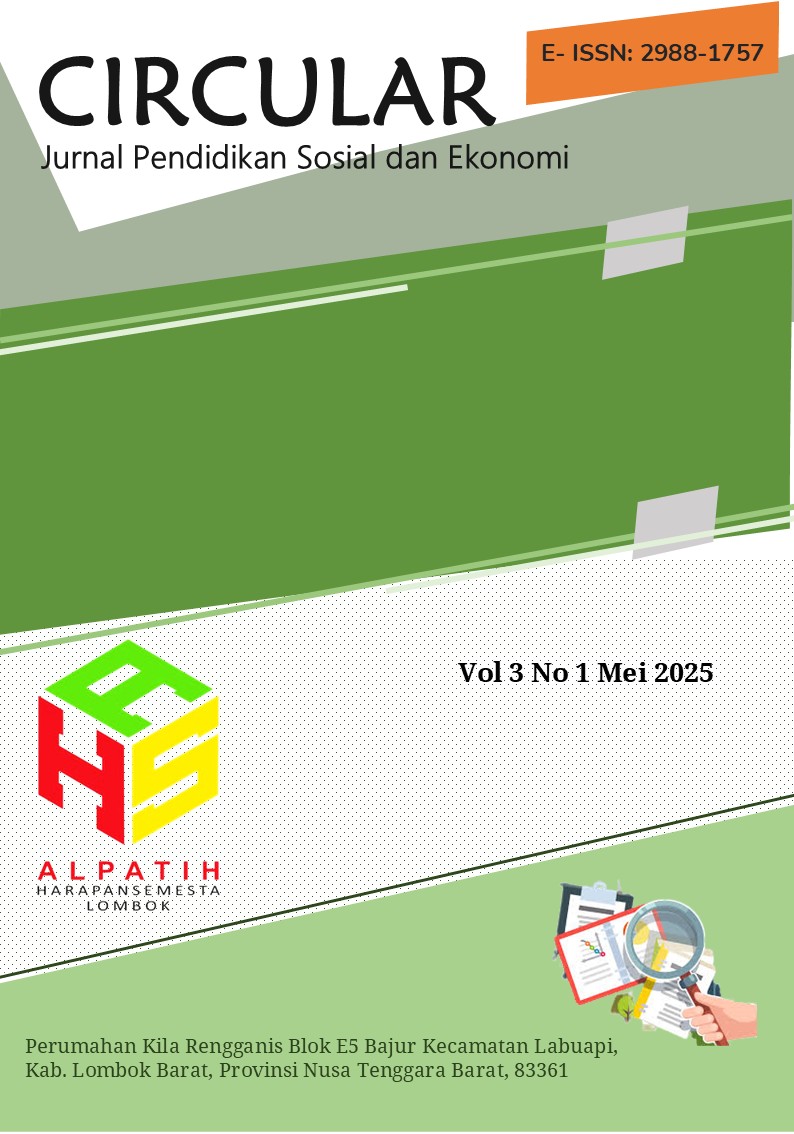Pengaruh Model Keseimbangan Umum terhadap Distribusi Kesejahteraan Masyarakat di Indonesia
DOI:
https://doi.org/10.70115/circular.v3i1.283Keywords:
CGE model; distribution of welfare; general equilibrium; happy economics; inequalityAbstract
This study aims to analyze the impact of the general equilibrium model (CGE) to be calculated on the happiness distribution in Indonesia. The study used a qualitative method by reviewing documents and described analysis, using secondary data from university magazines and official organizations such as BPS and OECD in 2018-2024. The results show that the CGE model can simulate the impact of economic policies on resource allocation and happiness distribution. The policy has been shown that food supply and cash transfer reduces income inequality without affecting the global economic efficiency. However, the limits occurred in the war against the imperfection of the market and complicated social environmental factors. The meaning of emphasizing the importance of integrating social justice in the CGE model to ensure that public policies in Indonesia are more comprehensive, adaptable and fairer.
References
Arifin, B. (2018). Analisis Dampak Kebijakan Pertanian terhadap Distribusi Pendapatan di Indonesia Menggunakan Model CGE. Jurnal Ekonomi Pembangunan, 19(2), 123–134.
https://ejournal.unsri.ac.id/index.php/jep/article/view/8756
Nugroho, S. & Siregar, H. (2021). Pengaruh Kebijakan Anggaran Terhadap Ketimpangan di Indonesia: Pendekatan CGE. Jurnal Perencanaan Pembangunan: The Indonesian Journal of Development Planning, 5(1), 1–16.
https://journal.bappenas.go.id/index.php/jpp/article/view/161
Handayani, S. & Nurkholis. (2020). Efektivitas Model CGE dalam Mewujudkan Keadilan Ekonomi: Studi Literatur. Jurnal Ekonomi dan Kebijakan Publik, 11(2), 102–115.
https://jurnal.dpr.go.id/index.php/ekp/article/view/1631
Mas-Colell, A., Whinston, M. D., & Green, J. R. (1995). Microeconomic Theory. New York: Oxford University Press.
Balasko, Y. (2011). The Equilibrium Manifold: Postmodern Developments in General Equilibrium Theory. Cambridge, MA: MIT Press.
Sen, A. (2017). Keadilan dan Pembangunan: Integrasi Sosial dalam Kebijakan Ekonomi. Jakarta: LP3ES.
Zulkardi. (2002). Developing A Learning Environment on Realistic Mathematics Education for Indonesian Student Teachers. Disertasi tidak dipublikasikan, Enschede: University of Twente.
OECD. (2010). PISA Results: What Makes a School Successful? Diakses pada 26 Maret 2012, dari
http://www.oecd.org/dataoecd/11/16/48852721.pdf
McKibben, B. (1992). The Age of Missing Information. New York: Random House.
Larson, G. W., Ellis, D. C., & Rivers, P. C. (1984). Essentials of Chemical Dependency Counseling. New York: Columbia University Press.
Cobb, P., & Gravemeijer, K. (2006). Design Research from a Learning Design Perspective. Dalam Akker, Gravemeijer, K., McKenney, S., & Nieveen, N. (Eds.), Educational Design Research (hal. 17–51). New York: Routledge.
Nahdi, K. (2009). Pola Pelibatan Wanita dalam Kelompok Masyarakat Program Inpres Desa Tertinggal (POKMAS IDT) di Kabupaten Lombok Timur. Jurnal EducatiO, 4(1), 1–15.
Hutauruk, E. T. R., Batubara, N. I. A., Fadilah, T. A., & Syakinah, W. (2025). Pengaruh Model Keseimbangan Umum terhadap Distribusi Kesejahteraan Masyarakat di Indonesia. Circular: Jurnal Pendidikan Sosial dan Ekonomi, 1(1), 1–3.
Badan Pusat Statistik (BPS). (2024). Laporan Ketimpangan dan Distribusi Pendapatan di Indonesia. Jakarta: BPS RI.
World Bank. (2023). Indonesia Economic Prospects: Securing the Recovery. Diakses dari
https://www.worldbank.org/en/country/indonesia/publication/indonesia-economic-prospects
Downloads
Published
Issue
Section
License
Copyright (c) 2025 Elisabeth Tamara Ratu Hutauruk, Nidia Izmi Azizah Batubara, Tri Ayu Fadilah, Wanda Syakinah

This work is licensed under a Creative Commons Attribution-ShareAlike 4.0 International License.
semua jurnal ini menjadi tanggung jawab penuh penulis, CIRCULAR memberikan akses terbuka kepada siapapun agar informasi dan temuan pada artikel bermanfaat bagi semua orang, CIRCULAR dapat diakses dan diunduh oleh siapapun tanpa dipungut biaya sesuai dengan lisensi creative common yang digunakan.






